Soldiers and drivers !!! !!
The subject of this article is a French truck that was used a lot by the German war effort. We are talking about the medium 4x2 truck Renault AHN 3,5 ton - Lastkraftwagen 3.5 ton.
 |
| Drawing modified from ACE French 3,5t truck (#72525) box art |
 |
| A brand new Renault AHN 3,5 ton truck for the German army. I can bet that this photo served as a model for the illustration above |
History:
In the mid-1930s, in response to a request from the French Army for a medium truck with 3 or 4 tonnes capacity, Renault introduced and produced the Renault AGR 4x2 truck in 1937. This vehicle with 3.5 tonnes of payload was very appreciated by the French Army, which bought several thousand of them.
 |
| Renault AGR 3,5 ton. 4x2 truck - 1938 |
In 1939, after Nazi Germany's invasion of Poland, triggering World War II, the Germans declared war on France on September 3, prompting the French Army to urgently order new vehicles.
Citroën wins a first contract with its U23 model but Renault figures prominently with its AGR. The manufacturer developing a new military family of vehicles, simple to produce and inexpensive, which is to replace the old and curvaceous AGR . It was the beginning of the Renault family of AHx trucks.
The Renault AHx was a range of light/medium trucks with carrying capacities from 2 to 5 tonnes manufactured by Renault between 1941 and 1947. Various versions were used in World War II by the German forces. The 4x2 trucks were the AHS, AHN and AHR models: light, medium and heavy, respectively.
The AHx range has a cab forward or COE (cab over engine) layout, a design introduced by Renault in 1934 and gradually extended to all its truck lineup.
Prototypes of the first AHx truck, the AHR, were unveiled by 1939. The initial objective, namely simplicity, appears to be achieved beyond all expectations. But that is not the only advantage of the AHR. Its design makes it particularly light. The prototype weighs 1500 kg less than conventional chassis. This has the direct consequence of increase in the same proportion the payload. Really, even with a payload and a motor the same power, an AHR truck carries more than traditional design. The prototype receives a cargo body with complete sheet metal flatbed and boards, because of the shortage of wood, a true problem in the spring of 1940. The cargo body has rear wheel fenders and the canvas tarp that is almost the same level as the cabin. With its diamond shaped all steel sides, rear wings and pigtails, the sheet steel prototype of the AHR can not hide its intended military destination.
 |
| The AHR 5,0 ton prototype - December, 1939 the widest of all versions |
On February 10, 1940 the prototype of the AHN leaves the Billancourt workshop. It is closely derived from the AHR but it has a four tonne payload, in stead of the five of it's bigger brother. The cabin is basically the same, although 12 centimeters smaller. The windshield is split into four parts with the top two opening. The front wings are curved. The AHN prototype differs from that of the AHR by its perforated disc wheels, that are not selected for the production series. Only the AHS will have them. Most parts are identical to those of the AHR with the exception of the front and rear axle, a simplification. The brakes are fitted with a hydraulic servo-mechanical unit. The body of the prototype AHN is also entirely metal like the AHR, it has only a side panel less. The AHN turnes out about 500 kg lighter compared to a traditional model with the same engine and payload.
 |
| The AHN 3,5 ton prototype - .February 10, 1940 Notice the completely flat appearance of the prototype surfaces and the perforated disc wheels |
Than the AHS is revealed, the last link of the range. It is a small truck with a 2.5 t payload. The AHS looks similar to the AHR and AHN but the cab is significantly smaller. 15 cm smaller than the AHN, and with the fenders protruding outside the cab. The windshield is also four parts with the top two opening. The windshield wipers are placed on the top front above the windshield. The lower part of the front is rounded, but that will not be retained on the production model. On the latter, the cab resembles, the width aside, those of the AHN and AHR. The top sheet above the windows is considerably more curved than the AHN. The AHS receives the four cylinder gasoline engine 105x85 as mounted on the AGC models (1.5 tons), AGS (500 kg) and AFP (1000 kg) and on the Novaquatre and Vivaquatre cars. The gearbox is four-speed and rear axle has single reduction. The straight frame is new. The diskwheels from pressed sheet steel, each have two slots. The brakes are hydraulically operated without aid. The body is very similar to the other two prototypes, but it still has a side panel less than the AHN.
 |
| The AHS 2,0 ton prototype The last and smallest of the range, follows the AHN shortly. It follows the lines of two other prototypes but it is significantly smaller, particularly in its width. |
To meet the range of vehicles with a load capacity of 2 tonnes, the Germans looked at the existing versions in production in France, finding the light trucks from Renault, Peugeot and Citroen.
The Renault AGC truck was designed to be used by the French Military on the 2 tonne carrying capacity group, but it was rejected by the French Military for this role.
 |
| Renault AGC truck - 1937. |
The Wehrmacht in turn, ordered the production of the AGC model. In German Army, French commercial lorries with a payload of about 2 tons offen were classified as Lastkraftwagen 2ton.. In the second half of the War, these were mainly vehicles of French manufacturers because the German industry manufactured only a few vehicles of this class at that time.
Peugeot DMA, Renault AHS and the Citroen U23 models were manufactured in large numbers, all trucks classified in the 2 ton payload class.
 |
Peugeot DMA truck - Lastkraftwagen 2ton. More than 15,300 exemplars were manufactured for the Wehrmacht. |
 |
| Renault AHS light truck - Lastkraftwagen 2ton. Wermacht - Notice the pressed wheels font: Piet van Hess |
About Renault AHx family, production begins effectively in March 1941 with the AHN1, then the range is quickly completed with the AHR1 and AHS2. These three production models differ from the prototypes by a number of details:
The AHS2 series can be identified by its different front-end. As the AHN1 and AHR1, its shape is not completely flat but gets a slight V-shape. The grille is the same on all models and adorned with a huge diamond in stamped and painted metal. The cab of the AHS2 is wider than that of the prototype (1.73 meter, including wings). The lower part of the front becomes an angular panel and the steering wheel gets four in stead of three spokes. The actual payload is increased to two tonnes. The last examples are delivered with artillery wheels of cast iron.
 |
| Renault AHS - Lastkraftwagen 2ton. in German hands DAK - North Africa Notice the casted wheels, typical of the late versions font: Piet van Hess |
 |
| A nice collection of new Renaults AHS - Lastkraftwagen 2ton. produced for the Germany Army font: Piet van Hess |
 |
| Renault AHS Lastkraftwagen 2ton. - Wermacht. Notice the 3 ton german cammo and the pressed early wheels. font: Piet van Hess |
 |
| Renault AHS Lastkraftwagen 2ton. A light truck on the immense plains of Russia |
 |
| Renault AHS Lastkraftwagen 2ton. - Security Service Notice the strange object in the front |
 |
| Brand new Renault AHS 1940 |
The AHN1 gets the same front with the diamond shape. The cab, with 2.13 meters at the wings was wider than that of the prototype AHN and the type 2 ton. AHS. The wheels were in casted iron and the wings were rounded.
 |
| Renault AHN1 -Lastkraftwagen 3.5 ton. in duties with Wermacht - Notice the Notek light font: Piet van Hess |
The Renault AHN was the successor of the Renault AGR and was produced for the Wehrmacht with the designation Lastkraftwagen 3.5 ton. They were robust, reliable trucks with excellent performance in road use, with many limitations in off-road use.
 |
| Renault AHN1 - Lastkraftwagen 3.5 ton. in Wermacht hands. font: Piet van Hess |
 |
| A brand new Renault AHN1 - Lastkraftwagen 3.5 ton. with his proud driver - Russain Front - 1942 font: Piet van Hess |
 |
| A beautiful example of a very well restored Renault AHN3 |
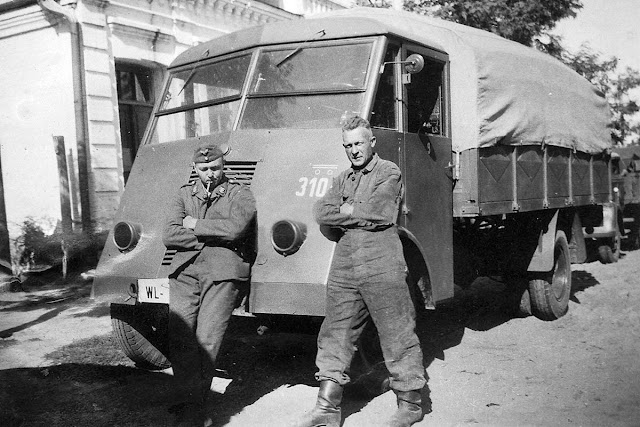 |
| Renault AHN1 Lastkraftwagen 3.5 ton. Luftwaffe markings font: Piet van Hess |
The AHR1, meanwhile, receives the same cab but the length at the rear axle is 11 centimeters longer than the AHN1. Front grille is identical to the rest of the range. The standard model receives a different rear axle, but still double reduction.
 |
| A very dirty Renault AHR at an Italian town -1943 Notice the horses in the cargo body and the Ford V3000 in background font: Piet van Hess |
 |
| News Renaults AHR on convoy. Cologne - Germany font: Piet van Hess |
 |
Renault AHR - 336th Infantry Division (Wehrmacht) Autumn 1942 - Taganrog region - Russian Front |
The Wehrmacht was supplied with about 23,000 AHS, 4,000 AHN, and between 1,000 and 2,000 AHR. The AHS has a 2.38-litre inline-four petrol engine (delivering 52 HP) while the AHN and AHR use a 4.05-litre inline-six petrol unit, the latter with a power output of 75 HP. The three models had a 4-speed manual gearbox. But, during the occupation, gasoline was the privilege of the German army. For the civilian market, all models are available initially with a Renault charcoal and wood gasifier and finally with Renault-Imbert wood-gasifier installation; easily recognizable by its pre-cleaner protruding horizontally at the front of the vehicle and its gas cooling radiator arranged flat on the front grille.
 |
Renault AHNH 1 with Renault-Imbert wood-gasifier Billancourt factory - January of 1943 font: Piet van Hess |
 |
| Leaflet about Renault-Imbert wood-gasifier installation Renault AHNH font: Piet van Hess |
Both the Renault AHS and the AHN have gasifier-equipped versions using engines similar to the petrol versions. These gasogen versions had the letter H at the end of their names.
The AHS version (AHSH) has a power output of 35 HP at 2,800 rpm while the AHN version (AHNH) has a power output of 52 HP at 2,800 rpm.
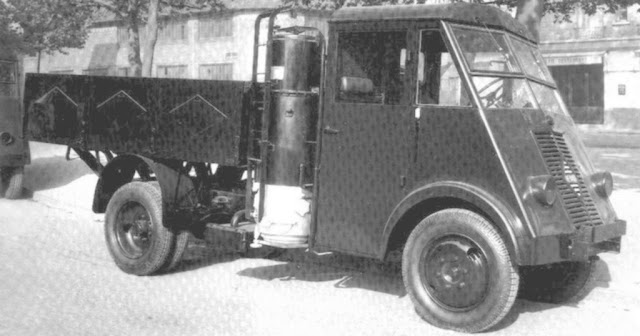 |
| Brand new civilian Renault AHSH Notice the gasogen apparatus, on the right side of the cargo area. That "stole" one of the "diamonds" on this side ... |
 |
| Renault AHNH gasogen. Amsterdan, 1943. Notice the gasogen apparatus, on the right side of the cargo area. That "stole" one of the "diamonds" on this side ... |
 |
| Renault AHRH gasogen The vehicle appears to do internal transportation at the Billancourt factory. |
 |
| Leaflet from Renault, 1941 showing an AHRH (gasogen) as central figure. font: Piet van Hess |
The three types are available from the factory with a flatbed body with wooden boards, the effective width and effective length vary depending on model. These boards are stamped sheet metal and each of the panels it is composed of is decorated with a wider than high diamond. The number of diamond increases with the length of the body: they are three in number on the AHSH (gasogen), four on the AHS2 (gasoline) and AHNH1 (gasogen), five on the AHN1 (gasoline) and AHRH1 (gasogen) and six on the AHR1 (gasoline).
After the war, evolutions of the AHS2 and AHN (AHS3/AHS4 and AHN2/AHN3) with 2 and 3.5 tonnes of payload respectively, were produced mainly for the civilian market.
The AHN version:
The first prototype is presented in February, 10 - 1940. Called AHN, the vehicle is very simple in design with a flat cabin, without protruding hood, tilted forward. We can consider that it is a semi-advanced cabin or COE. It offers a payload of 4 tons. It receives the approval of Army on February 14, 1941.
 |
| The Renault AHN 3,5 ton 4x2 truck prototype |
France was invaded before the production of the AHN and production will be for the sole benefit of the Wehrmacht from the month of March 1941. The vehicle was then called Renault AHN1 but its payload was lowered to 3.5 tonnes. The engine was a six-cylinder with four liters of displacement which develops 75 HP and which allows a top speed of 70 km/h. The vehicle was also ordered by the Vichy regime to replace its fleet of heavy goods vehicles, largely requisitioned by the German army.
 |
| Renault AHN1 Lastkraftwagen 3.5 ton. 6th SS Mountain Division Nord Notice the sides of cargo area in wood font: Piet van Hess |
 |
| Renault AHN1 Lastkraftwagen 3.5 ton. 5th SS Panzer Division Wiking - Army Group South - Kleist July, 1941 - Zhytomyr - Ukraine - Operation Barbarossa Notice the French helmet in the front grill, the russian gas mask in the right headlight and the pick attached to the right side of the cab |
 |
| Renaults.AHN1- Lastkraftwagen 3.5 ton. Wermacht - 6th Panzer Division - Kursk 1943 |
In May 1941, a gasogen version completes the AHN1 offer, called AHNH1, which will only be manufactured in only 271 units until December 1942. This civilian version was supposed to allow circulation despite the gasoline shortage. Intended primarily for the civilian market because the military had exclusive access to gasoline, the commerce had no outlet since during the occupation travel was almost prohibited.
 |
| Renault AHNH1 gasogen version Civilian version |
The early production batch AHN1 model are easily identifiable from other late models (AHN2 and AHN3) because their headlights are like cylindrical extensions on the front face of the cab.
Production will remain low because of the bombardments at the Renault plant in Boulogne Billancourt which affected the production, but also because some workers sabotaged the vehicles by depositing sand in the engine casings. They will be renamed by the Nazi army Renault Lastkraftwagen 3.5 ton.
 |
Pak 40 75mm AT gun with german gunners and Italian soldiers. In background, two Renaults AHN and Fiat 626 Rome, at corner between via Asiago and via Montello Italy - 1943 |
The production of the AHN was be restarted in November 1944 after the Billancourt factory was liberated by the allies. We then see the launch of the Renault AHN2 whose production is reserved for the French war effort. The Renault AHN2s was be sold on the civilian market, too. The modifications are minimal compared to AHN1. Production continues from November 1944 at June 1946, a period during which only 8,400 units will be produced. To this figure, it is advisable to add an odd gasogen version AHNH2 produced between October 1944 and May 1945 to 211 copies.
 |
| Brand new Renault AHN2 - 1945 Notice the headlights different, typical of this version |
The AHN experience a 3rd evolution in June 1946, with the AHN3. The evolution of the model is a little more visible with a low placement of the cargobed in compare to the earlier versions, lowered by 22cm, the length reduced by 12 cm and the width increased by 12 cm.
 |
| Renault AHN3 4x2 truck Notice the low placement of the cargobed in compare to the earlier version font: Piet van Hess |
 |
| Another renault AHN3 carrying sacks of coal France - 1947 font: Piet van Hess |
It will be manufactured from June 1946 to January 1947, in 2,000 copies. Its production was stopped in favor of the Renault 208E of 7 ton payload and Renault Galion. with 4 ton payload.
If you want to know even more about this line of French Trucks, I strongly recommend you to visit the fantastic website Renault AHx (AHS AHN AHR), from our friend Piet van Hess.
I thank the politeness and courtesy of Piet van Hess of allow me to used material from your site, to improve this article.
Again, thank you very much, Piet !!!
| Renault AHN | |
|---|---|
| Type | Medium truck |
| Manufacturer | Renault - France |
| Ass.Production | |
| Production | 1941–1947 (26.492) |
| Layout | Front-engine - 4x2 |
| Powertrain | |
| Engine Transmission Clutch Electric system | Renault 622-6 cyl.4.086cc 75 HP at 2800 rpm (gasoline) 4 forward+1 reverse single disc - dry 6 volts / 125Ah |
| Dimensions | |
| Lenght Widht Height Weight Fuel consum. Wheelbase Front track Rear track Tires Fuel tank Brakes | 6.420 mm 2.350 mm 2.870 mm (empty) 3.540 kg (incl. driver) 30L /100Km 3.730 mm 1.747 mm 1.610 mm 210 x 20 (4 kg infl. pres.) 100 L Hydraulic all wheels |
| Max speed | 70 Km/h |
The kit:
This is another commission work... My client request a French-German truck and as I had one of this girl sleeping in my closet, I decided to bring her to life !!! If you are thinking that I would build something like this:
 |
| Box arts ICM kit of Lastkraftwagen 3.5 ton (#35416) and his japanese clone from Tamiya (#32410), with 37mm AA gun. Both were highly criticized for their shapes and mainly wheels. |
... get ready for more radical and primitive things: the kit I am going to use is a resin kit from ADV Azimut Productions (#35094), for the past century...
 |
| Pic of ADV Azimut box kit (#35094) |
This kit was from that old time, as they say here in Brazil: "From the time that dogs was tied in the kennel with sausage!"
But enough with nostalgia and let's go to War: Kojak doing the reconnaissance of the terrain, knowing the parts of the kit ... made some disturbing discoveries: One of the PE sheets is not inside the box (Shame on you, ADV Azimut !!), but they are easily replaceable by scratch parts. Thankfully, the radiator grille came intact ... Another observation: warped parts !!!
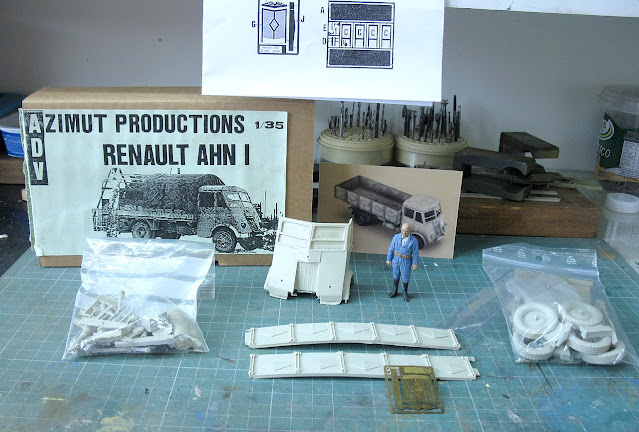 |
| Kojak a little worried... |
 |
| Slightly bent chassis and chassis frameworks definitely arched ... |
 |
| The floor of the cargo area is askew ... |
But flat pieces in resin usually look like this ... The best way to fix these flaws is to heat the water to an almost boiling point and dip the pieces inside, to "soften" the resin and allow us to plan the piece. The greatest care is not to overheat, as the repair can be worse than the defect with the part deforming irreversibly. The ideal is to do the thing little by little ...
 |
| Hot water in a glass bowl...About 80 ° C... Not boiling... If the glass bowl has a flat bottom, things are starting to look right ... |
After about 15 to 20 seconds in the heat, remove the piece and place it on a flat, cold surface. The granite countertop in the kitchen sink is ideal. Some weights (not exaggerated ...) on the piece keep the same flat and aligned .... Wait for the cooling, which is fast ...
 |
| The cargo area floor under pressure... |
 |
| Same method with chassis and chassis framework... |
 |
| As the frameworks are perfectly flat, they go directly to the cold granite .... |
 |
| Everything aligned ... Phew !!! |
 |
| The worst was the floor of the cargo area, but everything was correct !! |
 |
| The cargo area walls are also arched like the legs of a soccer player !! |
 |
| Holy crap!! |
 |
| Same problem ... same solution !! |
 |
| All ok, for now ... I think that's why Kojak is bald !!! |
As I said before, many times, alignment is all in one kit, especially when it comes to trucks. And when the truck is made of resin, things get wilder ... As much as you fall into the temptation to throw everything on the ground and stomp on it, take a deep breath and move on ...
 |
| Testing the alignment with the front suspension and the cab ... A crooked chassis destroys an entire project ... |
The interior of the cab is very poor ... and mine was also raffled with the absence of some pieces, such as the instrument panel, for example (Shame on you, Azimut ... again !!)
 |
| A very poor interior... let's scratch... |
 |
| Alignment of the front suspension and wheels. Metal parts are really Jurassic ... |
 |
| But Kojak (and his Lovely Assistants ...) achieved a good alignment result, after all ... |
 |
| The chassis and suspensions were aligned ... Another missing part: the internal rear wheels ... I'm starting to get really pissed off with this Azimut !!! |
 |
| I made some parts of the spare tire rack from scratch ... |
 |
| Who dares, wins !!! |
 |
| The cross-frame structure of the sub-chassis in position ... |
 |
| Testing...testing... |
 |
| Putting the doors in position (blue arrows) and small fractures in the cabin roof gutter (red arrows).... Notice the rear panel (external view) of the cabin |
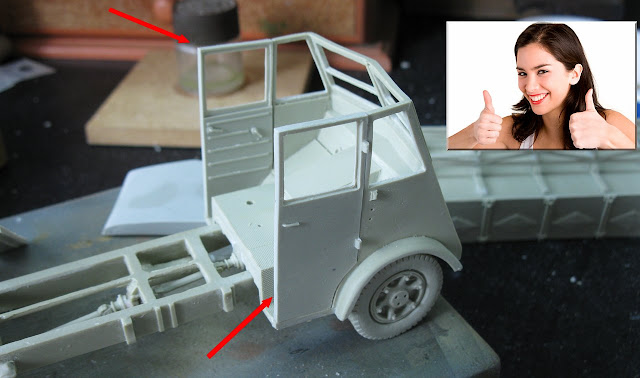 |
| Installation of doors in their locations is essential to allow satisfactory alignment of the cabin structure (red arrows) |
 |
| The fixing of these small details is a real pain in the ass. Bonding of very thin plastic with cyanoacrylate, in the gaps ... The excess will be removed with sandpaper, later ... |
 |
| Neuro-surgery done... Man, this sucks!! |
 |
| The "naked" interior"... |
 |
| And with some adds: clockwise: instrument panel; internal engine hood hinges; engine air filter; hood handle and vehicle pedals (100% scratch) |
 |
| Testing the roof's cabin |
 |
| And starting to paint the interior, so that we can close this step ... Panzer-gray tones ... |
I used some spare posters that were left over from my last work with MiniArt kits (GAZ-05-193 6x4 Staff bus) and glued them on the back wall of the cab. And it aroused my curiosity to know who the poster girl is(see red arrow below). Therefore, military models is also cinematographic culture: I introduce to you Marika Rökk, an actress from the 1940s with an interesting biography. This poster is a reproduction of the cover of the Filmwelt Magazine (Germany) from April 5, 1940.
 |
| Marika Rökk and a Nazi propaganda poster |
 |
| Cover of the Filmwelt Magazine (Germany) April 5, 1940, with the beautiful Marika Rökk. |
 |
| An important detail is to scrape the paint off the bonding surface, to avoid future accidents ....(red arrows) |
But to close the cabin, I need to do the final internal details. And one of the most important is the Renailt AHN instrument panel. As I said before, this piece was missing from my kit and after making the panel structure in scratch, it's time to make the octagonal multi-instrument typical of these trucks; I used Corel Draw and my laser-color printer to make the panel. I thought the result was quite good ....
 |
| The two decal layers, technique, already explained in other articles |
 |
| First I apply the white decal as a background and on that white decal, the transparent decal with the colors. The red and green details were applied with a brush. |
 |
| And with the steering wheel in place !!! Soooo cute!! |
Preparing to close the rear panel of the cab. A look at the strange position of the parking brake lever; horizontally on the rear panel !! Vive la France !!
 |
| Parking brakes lever (red arrow)...sooo weird!! |
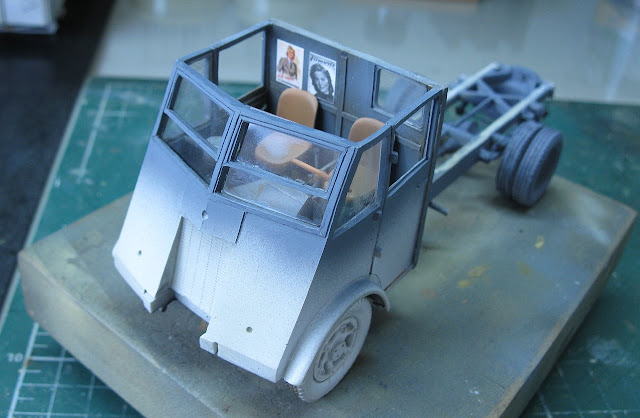 |
| Cabin closed without the roof... |
 |
| Right view... |
 |
| The solution: glue metal "bars" (disposable dental material: the elastics of orthodontic appliances are packed in these bars ...) with superglue and goodbye arching ... |
 |
| Straight as laser beams !!! |
As the infamous Azimut sold me a kit with many missing parts, now it's time to make the rear fenders from scratch. I cut 0.5 mm thick plasticard strips to the correct dimensions and, using paper tape, glued these two plastic strips to a metal cylinder, with a diameter similar to that of the rear wheels. I tightened the paper tape tightly and then dipped everything in boiling water for 1 minute. Then, I plunged into cold water. This thermal shock is an attempt to keep the plastic strips arched, without stress. I did this maneuver twice and, after about 30 minutes, I removed the strips (arched) from the adhesive tapes and put them at rest (with supports ...) until I could make the stirrups of the rear fenders. I used acupuncture needles for this... Shame on you, again, Azimut !!!
 |
| The metal tube, with plasticard strip in top... below, the 2 arched fenders, waiting their fate... |
 |
| The rear fenders in position, with the support sleepers made with acupuncture needles ... |
 |
| Right view... Man, I hate the Azimut!!!! |
 |
| Rear plate in position... Notice the spare wheel rack... |
 |
| The metal details are superb ... excellent (when they are in your kit!). Notice the headlights and Notek blackout light. |
 |
| Fuel tank in position. Again, the fuel tank lock was forgotten to be packed ... More scratch ... and more grudge against Azimut !! |
 |
| Rear license plate (red) , tow hook (blue) and spare wheel rack (green) |
 |
| The left view of Renault AHN... |
 |
| Right view... |
As I intend to make a load with canvas over it (and not the standard arches of the truck ...), I need to make mooring eyes on the cargo body ... Let's see the photos; BINGO!!!
 |
| Mooring eyes in the sides of the cargo area in this Renault AHN1 |
 |
| Copper wire and tiny holes... The wire is a recycling of old washing machine solenoids. The Planet thanks !!! |
 |
| Mooring eyes in position... |
 |
| More metal scratch: Towing hooks (pig tail) typically French (yellow) and the Notek light wiring (green)... Notice the plastic turn signals, scratch ... (another Azimut fault ..) (red) |
 |
| Notice the rear view mirror... |
 |
| The girl is ready!! Next, the markings and colors!! |
As I said, this vehicle is commission work and my client loves Waffen-SS vehicles. So, here are the clothes and makeup of our French-German girl: The happy days of the initial stages of Operation Barbarossa.
Our girl belongs to the Army Group South, under the command of Generalfeldmarschall Ewald von Kleist. She belonged to the Security Services (platoon A) of the 5th SS Panzer Division "Wiking", transporting materials in the vicinity of Zhytomyr, Ukraine, in July 1941. I introduce to you the lady n.3 of this platoon, called "MARGRET".
 |
| Masking with paper-tape and home made liquid mask... |
 |
| ...and with toilette paper, too... Panzer-Gray with tones... |
 |
After Future, decals for our Wiking Girl!! Renault AHN1 Lastkraftwagen 3.5 ton "MARGRET" Security Services (platoon A) - truck n. 3 Zhytomyr, Ukraine, in July 1941- Operation Barbarossa |
 |
| Matt varnish... |
 |
| Cargo made with styrofoam cut in the shape of crates ... |
 |
| Cargo in the cargo area... |
 |
| Opening the mooring eyes in the sides of the cargo area |
 |
| Much better... Now, time to load the girl... |
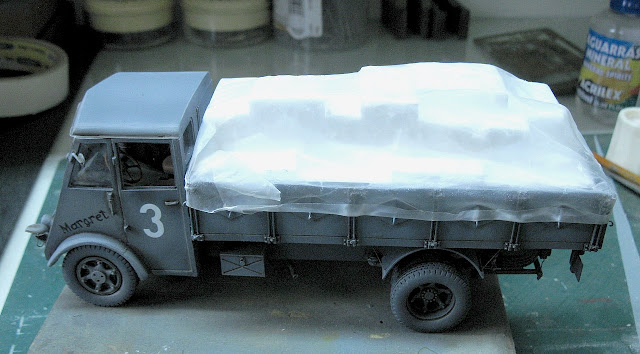 |
| Styrofoam in place and tracing paper as canvas. The Panzerserra technique: 50% water + 50% PVA glue... left side view |
 |
| Right view...after drying, paint !! |
 |
| And the painting of the canvas, after drying, tie with polyester thread (avoids that hairy aspect ...). The wooden trunks are branches of a Pomegranate (Punica granatum). Kojak hates getting bogged down in the Russian front !!! |
 |
| Rear view |
 |
| And right view. Notice the pick on the right side of the cab |
And after some final details and discreet weathering, I present to you MARGRET, a Renault AHN1 3,5 ton 4x2 truck - Lastkraftwagen 3.5 ton. She belongs to the Army Group South, under the command of Generalfeldmarschall Ewald von Kleist. She is part of the Security Services (platoon A, vehicle nr.3) of the 5th SS Panzer Division "Wiking", transporting materials in the vicinity of Zhytomyr, Ukraine, in July 1941.
 |
| Renault AHN1 Lastkraftwagen 3.5 ton "MARGRET" |
 |
| Renault AHN1 Lastkraftwagen 3.5 ton "MARGRET" left side |
 |
| Renault AHN1 Lastkraftwagen 3.5 ton "MARGRET" left side - top view |
 |
| Renault AHN1 Lastkraftwagen 3.5 ton "MARGRET" 3/4 rear left view |
 |
| Renault AHN1 Lastkraftwagen 3.5 ton "MARGRET" 3/4 rear left view |
 |
| Renault AHN1 Lastkraftwagen 3.5 ton "MARGRET" 3/4 rear right view |
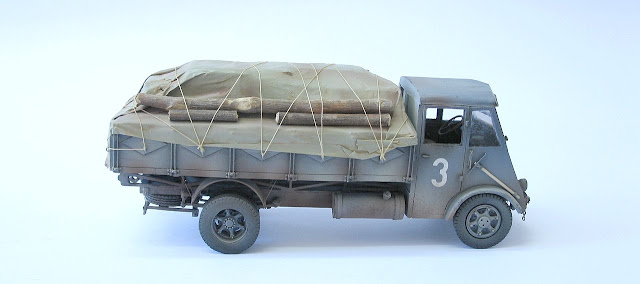 |
| Renault AHN1 Lastkraftwagen 3.5 ton "MARGRET" right view |
 |
| Renault AHN1 Lastkraftwagen 3.5 ton "MARGRET" |
 |
| Renault AHN1 Lastkraftwagen 3.5 ton "MARGRET" |
 |
| Renault AHN1 Lastkraftwagen 3.5 ton "MARGRET" |
 |
| She is beautiful!!! |
 |
| Renault AHN1 Lastkraftwagen 3.5 ton "MARGRET" with Kojak and Rover, the dog. |
 |
| Renault AHN1 Lastkraftwagen 3.5 ton "MARGRET" top front view |
 |
Renault AHN1 Lastkraftwagen 3.5 ton with for size comparison |
 |
| Renault AHN1 Lastkraftwagen 3.5 ton with Bedford halftrack prototype for size comparison...MARGRET is huge!!! |
 |
| Renault AHN1 Lastkraftwagen 3.5 ton with Bedford halftrack prototype |
See you soon, in the next job!!!






















